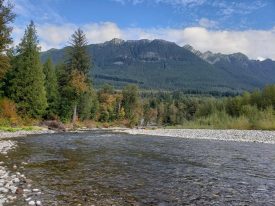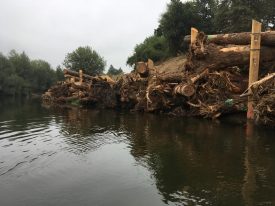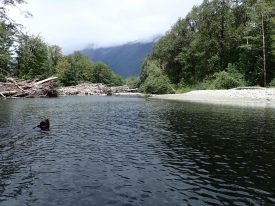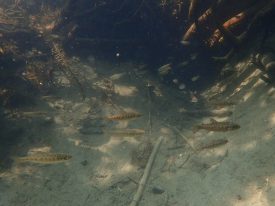SMEA SUMMER: RIVERS, RESTORATION, AND RESEARCH
By Ashley Bagley

My summer went swimmingly – in more ways than one! That’s because I spent most of my summer interning with King County on a salmon habitat restoration project along the Green River AND snorkeling the Stillaguamish River for my thesis research. One might say I really bring out the “E” in SMEA because I’m one of the few SMEA students who study stream and salmon ecology.
As an intern this summer for King County’s River and Floodplain Management section, I assisted senior ecologists and the project engineer on the construction of a large log habitat structure in the Lower Green River, a section of river that is very confined and in an urbanized area. This project was designed to create rearing habitat for juvenile Chinook (King) salmon during high flows and is one of many salmon recovery efforts occurring throughout Puget Sound. Needless to say, creating Chinook habitat in the Lower Green River is essential because it’s known for having minimal habitat availability and its summer stream temperatures can easily exceed the state’s thresholds for salmon. If you are new to Washington, then I should point out that increasing reproductive success of Chinook salmon is extremely vital to the success of the threatened Southern Resident Orca population, whose diet primarily consists of Chinook salmon. Being a part of the county’s efforts to put the “Kings” back in King County was a great experience for me to understand the full process (from permits to monitoring) that goes into making a habitat restoration project become a reality. Plus, I got to spend most of my days onsite at the river!

When I wasn’t working along the Green River, I was snorkeling in the north and south forks of the Stillaguamish River in Snohomish County for my thesis. In collaboration with my adviser, Cleo Woelfle-Erskine, the Stillaguamish Tribe of Indians, and Snohomish County, I developed a master’s thesis that seeks to create actionable science, builds upon existing efforts, and has a heavy field component. As someone who does not have a heavy science background, coming into SMEA I knew I wanted to tailor my master’s education towards gaining new experiences, such as primary data collection. Therefore, this summer I literally dove into field work.
My thesis focuses on understanding how side channels within the Stillaguamish River can provide refuge for salmon in the face of climate change. In order to do so, I spent most of my weekends snorkeling the north and south forks of the Stillaguamish River counting different types and age groups of salmon, characterizing the habitat we found salmon occupying, and collecting water quality data such as stream temperature and dissolved oxygen. This was no easy feat and would not have been possible without a crew of amazing volunteers – thank you! My goal for this project is to identify areas within the river where restoration will create the greatest increase in salmon habitat. Creating viable habitat for fall Chinook and coho in the Stillaguamish River is extremely important because climate models predict increased stream temperatures and lower stream flows, which can have detrimental impacts to salmon spawning and rearing in the river.

Since tribes are at the forefront of salmon recovery efforts within Puget Sound, I’m hoping the Stillaguamish Tribe will be able to use the data I collected this summer for future groundwater and surface water modeling, which can help inform the locations of their engineered log jams (ELJs) throughout the river. ELJs are relatively popular because they focus on “process-based restoration” techniques, meaning techniques geared towards restoring natural process across temporal and spatial scales. Now you must be wondering how this relates to salmon habitat… Well, the Tribe uses ELJs within the Stillaguamish River to divert streamflow and groundwater flow to a particularly dry area along the river. In doing so, this causes water to flow and wet the previously dry section of the river, thus, creating more complex habitat that is beneficial for adult salmon trying to spawn and juvenile salmon who are rearing. Collaborating with the Stillaguamish Tribe and Snohomish County has been instrumental in the development of my thesis, and I just hope my research can assist their efforts as they’ve assisted in mine.

Reflecting on my summer, you could say it was filled to the brim with rivers, restoration, and exciting research. Now with autumn quarter in full swing, analyzing my hard-collected primary data is the next step in my thesis journey (along with mastering R Studio!). However, with a newfound love of river snorkeling, I’m looking forward to getting back in the water next summer and collecting more data to support salmon recovery efforts in the Stillaguamish River.